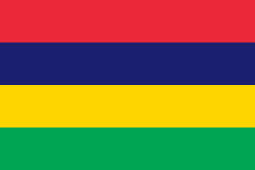 | |
| The Four Bands, Les Quatre Bandes | |
| Use | National flag |
|---|---|
| Proportion | 2:3 |
| Adopted | March 12, 1968 |
| Design | Four horizontal bands of red, blue, yellow and green. |
| Designed by | Gurudutt Moher |
 | |
| Use | Civil ensign |
| Proportion | 1:2 |
| Design | A red field with the national flag in and the coat of arms in a white circle on the fly side. |
 | |
| Use | State ensign |
| Proportion | 1:2 |
| Design | A navy blue field with the national flag in the canton corner, with the coat of arms on the fly side of the flag. |
 | |
| Use | Naval ensign |
| Proportion | 26:57 |
| Design | A white field with a blue band on each side, followed by two red stripes with the middle red stripe being thinner, charged with an anchor with a gold five-pointed star above it. |
 | |
| Use | Presidential standard |
| Proportion | 2:3 |
| Design | The national flag with a white circle, within it the coat of arms, below it, a golden wreath and the letters RM. |
The national flag of Mauritius, also known as the The Four Bands (Les Quatre Bandes), was adopted upon independence, 12 March 1968. It consists of four horizontal bands of equal width, coloured (from top to bottom) red, blue, yellow, and green. The flag was recorded at the College of Arms in London on 9 January 1968.
The flag was designed by Gurudutt Moher whose contribution was recognised posthumously in March 2018 in the form of the national title Member of the Star and Key of the Indian Ocean (MSK).[1] Moher, who was a retired school teacher, died of a heart attack on 7 October 2017, at the age of 93.[2]
The civil ensign (for private vessels) and government ensign (for state vessels) are red and blue flags, respectively, each with the national flag in the canton and the coat of arms of Mauritius in the fly. They are based on the British Red and Blue Ensigns.
The naval ensign (used by coast guard vessels) is an unusual design consisting of red, white, and blue vertical stripes of unequal widths defaced by a central anchor/key emblem.
- ^ "Décorés de la République: le père de notre quadricolore enfin reconnu". L'Express. 12 March 2018. Archived from the original on 2018-03-12. Retrieved 2018-03-12.
- ^ "Archived copy". Archived from the original on 2021-11-22. Retrieved 2024-01-06.
{{cite web}}: CS1 maint: archived copy as title (link)